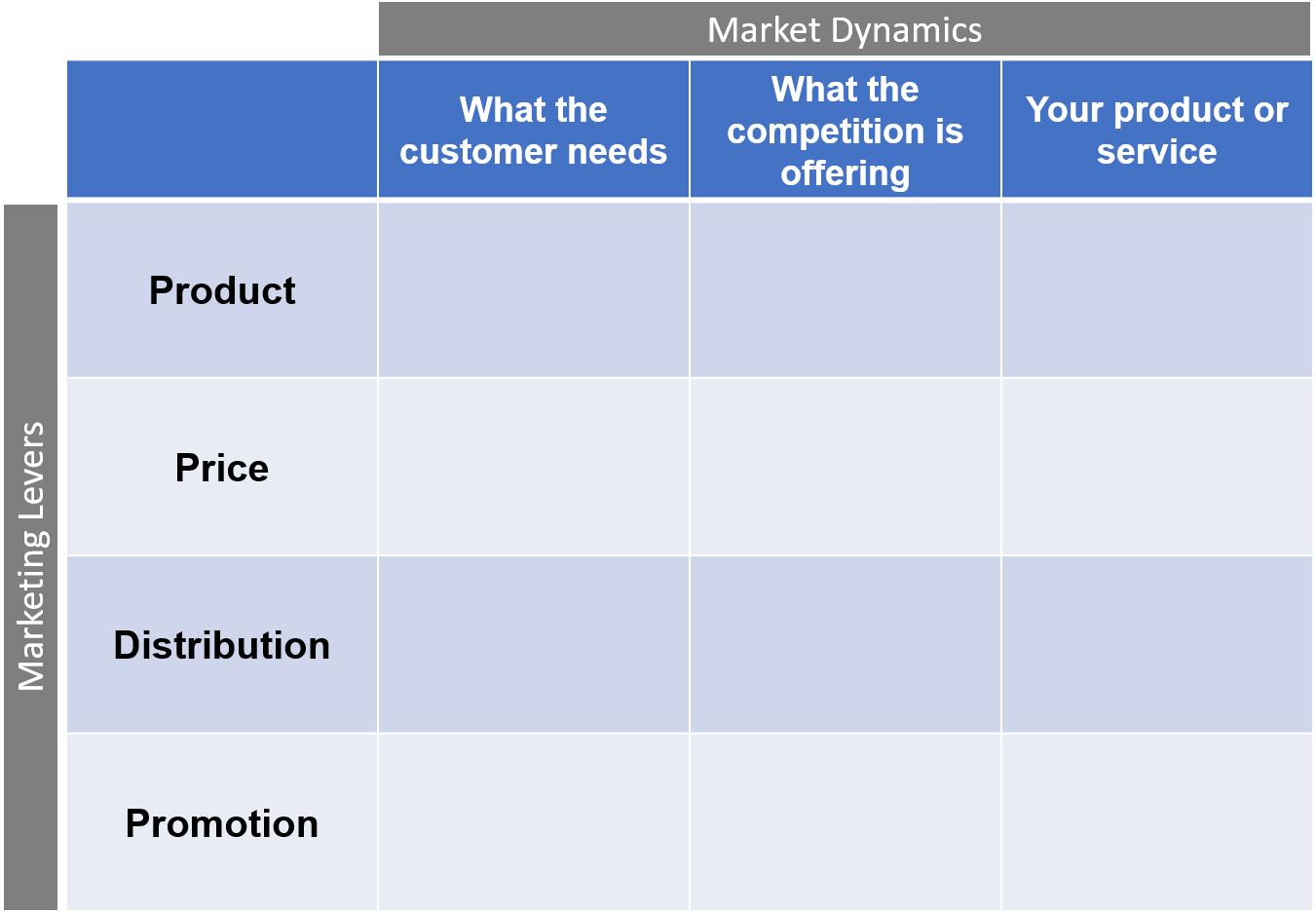02 March 2021
What is Marketing?
DEFINITION OF MARKETING: Business is the art of influencing customers. Marketing is about working out how.
The common view of marketing is that it is something you do to promote your products/services, most commonly for the purpose of boosting sales.
So, according to this view the main activity is delivering a sales message. Something like, "Buy Johnson's laundry detergent - it's great." And if that doesn't work, include a discount "Johnson's laundry detergent, now on special 30% OFF!"
Promotion (getting a sales message out there) is clearly a big and important part of the marketing process. And, being the most visible aspect of marketing, it is understandable that this activity is commonly refererd to as "marketing".
However, marketing is a more complex and thorough discipline that takes account of at least three broad realities: What it is that you offer, what your competitor's offer, and most importantly - what the customer is looking for.
And when you start delving into those three items looking for ways to gain competitive advantage, the topic quickly becomes complex.
the customer makes the decision to buy your product, your competitor's product, or to buy nothing at all. Marketing is an attempt to influence that decision.
The 'marketing concept' is that to achieve the firm's objectives, the needs and wants of consumers should be anticipated and satisfied more effectively than competitors.
To achieve this, you must have a thorough understanding of who your ideal customer is, what choices they have, and how to get inside their head to develop a preference for your product or service.
That's it. It is no more complicated than that.
Actually, it is complicated. It's complicated by the fact the above implies that LOGIC is the dominant factor at play, where as marketing is driven by emotion. The single most important truth is that, even in B2B markets, buyers are emotional creatures.
Marketing and buyer's emotion
A key component of marketing is understanding how consumers make buying decisions.
At the very least you want your customers to buy your product or service on a logical level.
At best you want them to be emotionally attached.
The ultimate: they buy your product or service because it defines who they are

So, much of the marketer’s work is about developing this customer insight, shaping the product attributes to achieve a superior value proposition and then working out the most cost-effective way to cut through the clutter to deliver the right marketing messages to create this emotional connection.
To reiterate the point (because it's an important one), marketing is primarily about the customer. The firm that understands who they are selling to best (the target market) will have a distinct advantage over the competition.
Branding, positioning, and market segmentation
Because products and services compete for the attention of customers, marketers need to use the right marketing tactics to fight for a place in the customers’ minds.
Marketers need to first consider how they wish to position their product or service which is about establishing where the product or service sits on several commonly expected dimensions such as price, quality, performance, category, style and many other attributes.
Projecting consistent messages and image requires the discipline of developing a specification for both positioning and branding, Branding is another device used to establish the identity, personality and image of the product or service.
Finally, developing positioning and brand can best be achieved by having a clear understanding of who the customer is and how they think and feel about the world. You need to understand their emotional triggers.
This leads to a third important concept - segmentation. All customers who might be considered potential buyers are not the same and may have varying views of the world and differing emotional triggers. Marketers need to identify the market segments and make the decision to appeal to all segments or narrow the field to optimise for success.
Correct positioning and branding are powerful tools for establishing an emotional connection and developing a clear view of the market segments to be targeted helps clarify the decisions necessary to develop a powerful marketing strategy.
Does emotional connection work for B2B products?
Let's use cars as an example to explore the emotional connection.
I think we all understand how people make car buying decisions based on their own self-image. However, buying decisions are complicated by practical reality; I might see myself as a Ferrari person but I can't afford one and/or it might not be practical for taking the kids to school. Despite this, Ferraris seem to find customers to buy them (read more about psychographic profiling and ethnographic research).
What about buying concrete? Supplying concrete is a business; does the marketing manager of a concrete supplier need to worry about the emotional connection with the people who place orders for concrete? The answer is "yes" but in a different way. This article will explain the specialized approach companies take to the marketing of industrial products B2B Marketing: selling planes, trains and widgets.

Suffice to say when placing an order for any product (consumer or industrial) at some point a person will consider their confidence about making the right decision. It's an emotional response. The least successful method of achieving a competitive advantage is to aim to have the lowest price. The practice of marketing is about hunting for ways to gain a competitive advantage without always resorting to the lowest price.
People regularly pay more for a product, if they perceive a reason to do so. This concept is called value. Marketing is about developing a value proposition and communicating it to likely buyers (the target market).
The person in a construction company or concreting contractor placing an order for 10 truckloads of concrete will be looking for a supplier who can deliver at the right price, meet the schedule, deliver the specified grade of concrete, and do it reliably. You don't want to be halfway through the pour and the last 5 trucks arrive late or not at all. Likely he/she will place the order with a supplier they trust (that's called branding) and they'll do this because they are an experienced, construction industry professional - it defines who they are.
So, while there may be cheaper suppliers of exactly the same concrete, they might be less reliable. Thus the product concept is not just the product itself, it is a bundle of at least the physical product and the service that accompanies it.
The Marketing Triangle
Market dynamics is a broad term to describe the interplay between three players...
- The nature and attributes of your product or service
- What the customer needs to solve their problem
- What the competition is offering

Of course, both "the customer" and "the competition" are mostly more than one, making the dynamic more complex.
Inherent in this definition is the concept of competitive advantage, which is achieved by manipulating the Four Levers of the marketing model...
The Four Marketing Levers
This assists with understanding the Marketing Triangle, the customers' needs and the product offerings are dissected into four categories...
The Four Levers are traditionally referred to as the Marketing Mix or the Four P's.
Over the years, many people observe new trends and technologies in marketing (not the least of which has been the rise of internet/online/digital marketing), thus calling into question the relevance, value and applicability of the 4 P's model. This is a topic that I will write about separately later. Suffice to borrow an observation from music; before you can improvise you must first master the original piece. Jumping straight to improvisation might lead one to suspect you chose to avoid this odious step.
The difference between marketing and promotion
Most people confuse 'Marketing' with 'Promotion'; as you can see from the above list (the four levers)...
Promotion is a subset of the total marketing concept.
Marketing includes promotion. Promotion specifically refers to a wide range of activities intended to build brand awareness and generate leads (for example advertising) or to transact the sale (for example direct selling). In traditional marketing theory, all the many promotional techniques are referred to as the Promotions Mix.
Promotion is the most visible manifestation of marketing and hence is often referred to as "marketing".
However, the danger is that by thinking marketing only refers to the promotion component leads many firms to overlook the discipline of undertaking the development of a true marketing strategy and hence miss the opportunity to develop a powerful value proposition.
Many marketing managers are more properly advertising managers
...because they have little say in the product strategy, pricing, and distribution decisions.
That leaves only promotion. To be fair, in terms of management time, executing promotional activities can be (depending on the industry) a significant component of a marketing manager's work. However, only having responsibility for the promotions strategy (and decision-making power) weakens the organisation's ability to develop a competitive advantage.
The marketing mix is often split across the organisation with strategic decisions allocated to different silos...
Often R&D and manufacturing decide what the product is, finance decides the price (usually using a cost-plus pricing model), the distribution strategy was set long ago and is rarely reviewed and the marketing manager is told "go get us some sales leads. This is your budget."
Total responsibility for the firm's marketing strategy doesn't need to be given to one person (a marketing manager) but should be reviewed in its entirety (Product, Price, Distribution and Promotion) through some regular process.
Many firms miss out on the strategic benefits of employing a professional marketing manager by limiting their portfolio of responsibility to the promotions mix because they do not understand the word "marketing" - that's not to say the marketing manager should be given unfettered right to control all aspects without review by others in the management team - however, just as the finance manager cannot be expected to manage finances without having oversight of all finances, the marketing manager will not have the ability to develop and recommend strategy without considering the entire marketing mix.
The key symptom of the misunderstood marketing manager is the tendency to look for a person with "creative flair"
...certainly, many marketers have this attribute however marketing (as befits the definition above) is just as much analytical requiring (at least) numeric skills as it is creative. Worse, some firms take their best salesperson and give them the title "marketing manager".
Marketing is a management discipline requiring a broad skill set.
The marketing department
However, in large firms managing a portfolio of products, the responsibility for developing and implementing a marketing strategy is assigned to several product managers (sometimes called "brand managers") who may each manage one important product or a portfolio.
Their job entails recommending the marketing strategy, developing the marketing plan, and project managing its implementation. A group of product managers are supervised by the General Manager Marketing (sometimes called "Marketing Director" or "Vice President Marketing").
The product manager
The product manager may set the marketing strategy annually but throughout the year is constantly monitoring sales results, competitor analysis, implementing promotions, briefing distributors and working on joint business plans, undertaking customer research, producing sales forecasts and management reports, and liaising with the sales department. The marketing strategy is constantly reviewed and adjusted in response to new data.
The product manager also has responsibility for ensuring the product specification maintains its attractiveness to the customer and keeps pace with new technology, changes in legislation, and any other external trend. The product manager will likely be working with product development specialists, manufacturing and others to make improvements or be working on the next new release.
Having a person dedicated to constantly monitoring the market and adjusting the marketing strategy leads to the development of sophisticated tools and methods and a highly responsive approach. This provides larger firms who can afford to employ marketing specialists a considerable advantage over smaller players.
Different businesses have different approaches to the concept of product management. The above explanation is oriented to a manufacturing organization. Large retailers and wholesale distributors for example employ "category managers" (sometimes called "buyers"); their product development responsibility consists of researching the best available products (often from global manufacturers) and negotiating/renegotiating supply contracts and/or distribution agreements.
The role of distributors
Wholesalers and retailers who sell products manufactured by others have a range of relationships with their suppliers. In some cases, the buyers have the power. Access to their retail outlet is critical to the manufacturer's success and they know the retailer has alternatives. This is particularly true of consumer goods sold through supermarket chains and hardware products.
However, in technical product markets often the manufacturer has the power and being appointed a distributor of a market-leading technology brand is a prized achievement. In this situation, the wholesale distributor has two customers - their suppliers and their buyers. Keeping both happy while still making a profit is a juggling act.
Marketing Strategy Matrix

The marketing strategy matrix (depicted) shows the relationship between the **Four Marketing Levers** and the **Marketing Triangle**.
The development of a marketing strategy is achieved by undertaking sufficient research and analysis to inform writing succinct statements in each cell in the above matrix. After collecting a lot of research to understand the market dynamics, you want to distil this information into tight summarized statements to put in the grid so you can stand back, look at it, discuss it with colleagues, and make an informed decision.
The firm has no control over the first two columns (Customer & Competition), and must simply find out and report "what is"; however, the final column "Your Product or Service" is what the firm can control.
Exerting this control is called "marketing"
Developing a competitive advantage is about deciding how you will make your offering superior to the competition by better matching the customer's needs than your competitors in one (or all of) Product, Price, Distribution, and Promotion. The net result of this analysis is the development of a positioning strategy.
Superiority in one (or all) will provide "leverage" over your competition hence why we refer to Product, Price, Distribution and Promotion as The Four Marketing Levers.
Developing the all-important "emotional attachment" is a long term marketing objective where the planets are in perfect alignment between your Product, Price, Distribution and Promotion and the customer's perception of what best matches their need.
The principal concepts are...
- Market segmentation: not all people are the same. Segmentation means dividing the customers up into groups having common attributes, attitudes and behaviours. Thus, the market segment matrix above may need to be repeated for each market segment (if you're targeting more than one).
- Positioning: Matching the marketing mix (the four levers) to the requirements of the market segment. Some products are positioned as 'premium' and have product features and pricing to match, others are deliberately positioned as low-cost alternatives. However, positioning can have many dimensions. You can read more about positioning here.
- Branding and image: Developing a firm product concept, recognition and awareness of your product and how it is positioned in the collective minds of the people making up your target market segment.
- Promotion: This Is the collection of communication tools and sales activities designed to inform the target market to help establish a brand, image, value proposition and call to action required to make sales happen.
The difference between Marketing Strategy and Marketing Planning
A Marketing Strategy is not the same as a Marketing Plan.
However, clearly, the two are linked; the marketing strategy informs the marketing plan.
The marketing strategy is a statement defining how the firm will achieve competitive advantage (as described above), the marketing plan is the proposed process and tasks for implementing the marketing strategy, typically including a timetable and budget.
The marketing plan typically describes the planned promotional activities, however, it should include all aspects of the marketing mix, particularly where significant product development is required, and arrangements are needed to set up distribution channels.
Marketing is multi-disciplinary
The setting of marketing strategy (making decisions about product, price, distribution and promotion) does not happen in a vacuum; it will involve discussion with other specialists in the organisation. A marketing manager or product manager needs to consider the practical realities of their strategic decisions.
The main consideration is the financial consequences of the marketing strategy.
Building the best product often means that it needs to be sold at a higher price to make a profit. However, if the market segment that the high spec product is designed for is too small, the volume of sales achieved may not be sufficient to recoup the R&D cost, manufacturing costs, and promotional costs to deliver an acceptable profit.
Hence, the development of the marketing strategy has to be guided by financial feasibility.
To obtain the cost inputs to build the feasibility model (depending on the product or service) may require working with product engineers and manufacturing managers.
The sales department will want input as well. The average sales cycle required (will it take 1 day or 3 years to close the average sale?), what adjustments to the sales plan will be required (is this a product that requires a dedicated focus or can they tuck it under their arm and sell it alongside existing product lines?) and if distributors are involved what is their view?
=========================================================
In any organization, each department (finance, manufacturing/operations, IT, customer service, sales, marketing, R&D, perhaps even HR) will have a view their department is the most important. Typically, they assume "without them, this organisation would cease to function." In fact, they're right. They're ALL right.
However, the customer has the final say. The marketing department's job is to understand the customer and ensure the entire organization is oriented toward better satisfying their needs than the competition. And do it profitably.
Further reading
What is positioning?
What is branding?
What is market segmentation?
Product strategy
Price strategy
Place Strategy
Distribution strategy
Promotion strategy
